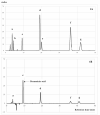Inhibitory Effect of a Rosmarinic Acid-Enriched Fraction Prepared from Nga-Mon (Perilla frutescens) Seed Meal on Osteoclastogenesis through the RANK Signaling Pathway
- PMID: 33671207
- PMCID: PMC7923133
- DOI: 10.3390/antiox10020307
Inhibitory Effect of a Rosmarinic Acid-Enriched Fraction Prepared from Nga-Mon (Perilla frutescens) Seed Meal on Osteoclastogenesis through the RANK Signaling Pathway
Abstract
The aim of this study is to determine antioxidant and anti-inflammatory activities relating to the antiosteoporosis effects of various perilla seed meal (PSM) fractions. The remaining waste of perilla seed obtained from cold oil compression was extracted with 70% ethanol and sequentially fractionated according to solvent polarity with hexane, dichloromethane, ethyl acetate, and water. The results indicated that the seed-meal ethyl acetate fraction (SMEF) exhibited the highest antioxidant and anti-inflammatory activities, and rosmarinic acid (RA) content. The signaling pathways induced by the receptor activator of the nuclear factor kappa B (NF-κB) ligand (RANKL) that trigger reactive oxygen species (ROS) and several transcription factors, leading to the induction of osteoclastogenesis, were also investigated. The SMEF clearly showed attenuated RANKL-induced tartrate-resistant acid phosphatase (TRAP)-positive multinucleated osteoclasts and TRAP activity. A Western blot analysis showed that the SMEF significantly downregulated RANKL-induced NF-κB, AP-1 activation, and the nuclear factor of activated T-cell 1 (NFATc1) expression. SMEF also suppressed RANKL-induced osteoclast-specific marker gene-like MMP-9 using zymography. Furthermore, the SMEF showed inhibition of RANKL-induced ROS production in RAW 264.7 cells. The results suggest that the SMEF, which contained high quantities of RA, could be developed as a natural active pharmaceutical ingredient for osteoclastogenic protection and health promotion.
Keywords: Nga-Mon (Perilla frutescens); RANKL; ROS; anti-inflammation; antioxidant; osteoclastogenesis.
Conflict of interest statement
The authors declare no conflict of interest.
Figures






Similar articles
-
Molecular Mechanism of Antioxidant and Anti-Inflammatory Effects of Omega-3 Fatty Acids in Perilla Seed Oil and Rosmarinic Acid Rich Fraction Extracted from Perilla Seed Meal on TNF-α Induced A549 Lung Adenocarcinoma Cells.Molecules. 2021 Nov 9;26(22):6757. doi: 10.3390/molecules26226757. Molecules. 2021. PMID: 34833849 Free PMC article.
-
Neogambogic Acid Suppresses Receptor Activator of Nuclear Factor κB Ligand (RANKL)-Induced Osteoclastogenesis by Inhibiting the JNK and NF-κB Pathways in Mouse Bone Marrow-Derived Monocyte/Macrophages.Med Sci Monit. 2018 Apr 26;24:2569-2577. doi: 10.12659/MSM.909651. Med Sci Monit. 2018. PMID: 29698379 Free PMC article.
-
Anti-Osteoporosis Effect of Perilla frutescens Leaf Hexane Fraction through Regulating Osteoclast and Osteoblast Differentiation.Molecules. 2022 Jan 26;27(3):824. doi: 10.3390/molecules27030824. Molecules. 2022. PMID: 35164085 Free PMC article.
-
The Effects of Aronia melanocarpa 'Viking' Extracts in Attenuating RANKL-Induced Osteoclastic Differentiation by Inhibiting ROS Generation and c-FOS/NFATc1 Signaling.Molecules. 2018 Mar 8;23(3):615. doi: 10.3390/molecules23030615. Molecules. 2018. PMID: 29518052 Free PMC article.
-
Comprehensive Review of Biological Functions and Therapeutic Potential of Perilla Seed Meal Proteins and Peptides.Foods. 2024 Dec 27;14(1):47. doi: 10.3390/foods14010047. Foods. 2024. PMID: 39796337 Free PMC article. Review.
Cited by
-
Phytochemical Composition and Antioxidant and Anti-Inflammatory Activities of Ligularia fischeri Turcz: A Comparison between Leaf and Root Extracts.Plants (Basel). 2022 Nov 7;11(21):3005. doi: 10.3390/plants11213005. Plants (Basel). 2022. PMID: 36365457 Free PMC article.
-
Local Wisdom and Diversity of Medicinal Plants in Cha Miang Forest in Mae Kampong Village, Chiang Mai, Thailand, and Their Potential for Use as Osteoprotective Products.Plants (Basel). 2022 Jun 1;11(11):1492. doi: 10.3390/plants11111492. Plants (Basel). 2022. PMID: 35684265 Free PMC article.
-
Anthocyanins from a new hybrid sweet potato peel cultivated in Northern Thailand mitigate LPS-induced inflammation and RANKL-induced osteoporosis by regulating ROS-mediated pathways.Inflammopharmacology. 2025 Jan;33(1):381-399. doi: 10.1007/s10787-024-01634-5. Epub 2025 Jan 13. Inflammopharmacology. 2025. PMID: 39806052 Free PMC article.
-
Perilla Seed Meal Extract Enriched with Rosmarinic Acid and Luteolin: Natural Active Pharmaceutical Ingredients (NAPIs) for Osteoprotective Effects.Antioxidants (Basel). 2025 Aug 8;14(8):973. doi: 10.3390/antiox14080973. Antioxidants (Basel). 2025. PMID: 40867869 Free PMC article.
-
Molecular Mechanism of Antioxidant and Anti-Inflammatory Effects of Omega-3 Fatty Acids in Perilla Seed Oil and Rosmarinic Acid Rich Fraction Extracted from Perilla Seed Meal on TNF-α Induced A549 Lung Adenocarcinoma Cells.Molecules. 2021 Nov 9;26(22):6757. doi: 10.3390/molecules26226757. Molecules. 2021. PMID: 34833849 Free PMC article.
References
Grants and funding
LinkOut - more resources
Full Text Sources
Other Literature Sources
Miscellaneous

